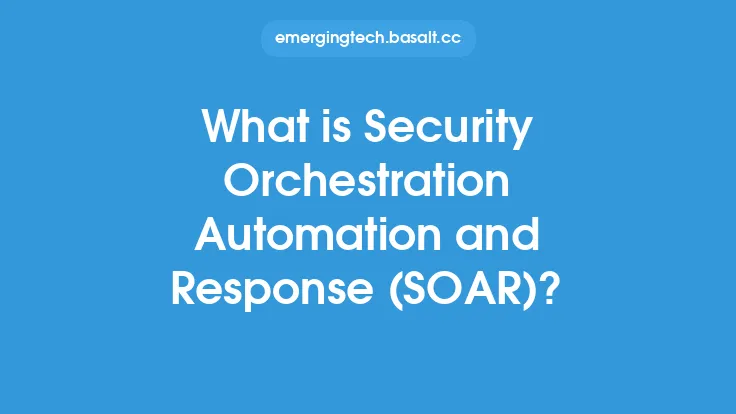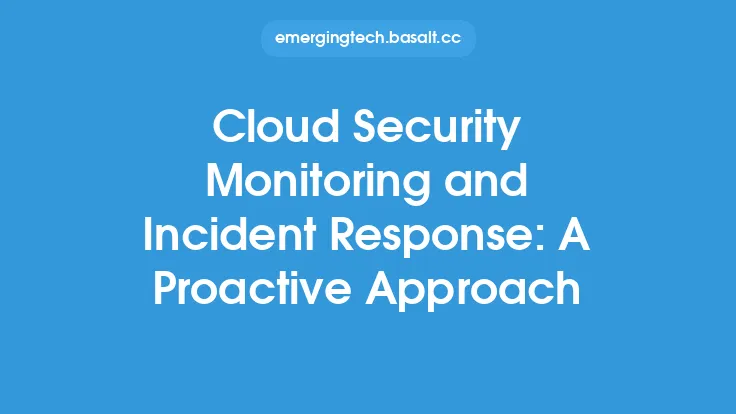In today's complex and ever-evolving cybersecurity landscape, organizations face numerous challenges in detecting, responding to, and mitigating security threats. The sheer volume of security alerts, combined with the shortage of skilled cybersecurity professionals, can lead to alert fatigue, delayed response times, and increased risk of security breaches. To address these challenges, Security Orchestration Automation and Response (SOAR) has emerged as a critical component of modern cybersecurity strategies. By streamlining security operations, SOAR enables organizations to respond more effectively and efficiently to security incidents, reducing the risk of breaches and minimizing the impact of successful attacks.
Introduction to Security Orchestration Automation and Response
Security Orchestration Automation and Response (SOAR) is a solution that combines security orchestration, automation, and response capabilities to help organizations manage and respond to security incidents more effectively. SOAR solutions integrate with various security tools and systems, such as security information and event management (SIEM) systems, threat intelligence platforms, and incident response tools, to provide a unified platform for security operations. By automating repetitive and mundane tasks, SOAR enables security teams to focus on higher-value activities, such as threat hunting, incident response, and security analytics.
Key Components of SOAR
A typical SOAR solution consists of several key components, including security orchestration, automation, and response. Security orchestration refers to the process of integrating and coordinating multiple security tools and systems to provide a unified view of security operations. Automation involves the use of workflows, playbooks, and scripts to automate repetitive and mundane tasks, such as data enrichment, threat intelligence lookup, and incident response. Response refers to the process of responding to security incidents, including containment, eradication, recovery, and post-incident activities. Other key components of SOAR include incident management, threat intelligence, and security analytics.
Security Orchestration
Security orchestration is a critical component of SOAR, as it enables organizations to integrate and coordinate multiple security tools and systems. This includes SIEM systems, threat intelligence platforms, firewalls, intrusion detection systems, and incident response tools. By integrating these tools and systems, security orchestration provides a unified view of security operations, enabling security teams to respond more effectively to security incidents. Security orchestration also enables organizations to automate workflows and playbooks, reducing the risk of human error and improving response times.
Automation
Automation is another key component of SOAR, as it enables organizations to automate repetitive and mundane tasks. This includes tasks such as data enrichment, threat intelligence lookup, and incident response. By automating these tasks, security teams can focus on higher-value activities, such as threat hunting, incident response, and security analytics. Automation also enables organizations to respond more quickly to security incidents, reducing the risk of breaches and minimizing the impact of successful attacks. Common automation use cases include phishing incident response, malware analysis, and vulnerability management.
Response
Response is a critical component of SOAR, as it enables organizations to respond more effectively to security incidents. This includes containment, eradication, recovery, and post-incident activities. By automating response workflows and playbooks, organizations can reduce the risk of human error and improve response times. Response also involves the use of threat intelligence and security analytics to inform response decisions and improve the effectiveness of incident response. Common response use cases include incident response, threat hunting, and security analytics.
Benefits of SOAR
The benefits of SOAR are numerous and well-documented. By streamlining security operations, SOAR enables organizations to respond more effectively and efficiently to security incidents, reducing the risk of breaches and minimizing the impact of successful attacks. SOAR also enables organizations to improve incident response times, reduce the risk of human error, and increase the productivity of security teams. Other benefits of SOAR include improved threat intelligence, enhanced security analytics, and better compliance and regulatory reporting.
Implementation and Integration
Implementing and integrating SOAR requires careful planning and execution. This includes defining security workflows and playbooks, integrating security tools and systems, and automating response processes. Organizations should also develop a comprehensive incident response plan, including procedures for containment, eradication, recovery, and post-incident activities. Common integration use cases include SIEM system integration, threat intelligence platform integration, and incident response tool integration.
Security Orchestration Automation and Response Tools
There are numerous SOAR tools available, each with its own strengths and weaknesses. Common SOAR tools include Splunk Phantom, Demisto, and IBM Resilient. When selecting a SOAR tool, organizations should consider factors such as integration with existing security tools and systems, automation capabilities, and response workflows. Organizations should also consider the scalability and flexibility of the SOAR tool, as well as its ability to support custom workflows and playbooks.
Best Practices for Security Orchestration Automation and Response
Best practices for SOAR include defining clear security workflows and playbooks, automating repetitive and mundane tasks, and integrating security tools and systems. Organizations should also develop a comprehensive incident response plan, including procedures for containment, eradication, recovery, and post-incident activities. Other best practices include continuously monitoring and evaluating SOAR effectiveness, providing training and support for security teams, and staying up-to-date with the latest SOAR trends and technologies.
Common Use Cases for Security Orchestration Automation and Response
Common use cases for SOAR include phishing incident response, malware analysis, and vulnerability management. SOAR can also be used to automate threat intelligence workflows, such as threat lookup and enrichment. Other use cases include incident response, threat hunting, and security analytics. By automating these use cases, organizations can improve incident response times, reduce the risk of human error, and increase the productivity of security teams.
Challenges and Limitations of Security Orchestration Automation and Response
Despite the numerous benefits of SOAR, there are several challenges and limitations to consider. These include the complexity of integrating multiple security tools and systems, the need for custom workflows and playbooks, and the potential for automation to introduce new security risks. Organizations should also consider the scalability and flexibility of SOAR tools, as well as their ability to support custom workflows and playbooks. By understanding these challenges and limitations, organizations can better plan and execute SOAR implementations, maximizing the benefits of this critical cybersecurity technology.
Conclusion
In conclusion, Security Orchestration Automation and Response (SOAR) is a critical component of modern cybersecurity strategies. By streamlining security operations, SOAR enables organizations to respond more effectively and efficiently to security incidents, reducing the risk of breaches and minimizing the impact of successful attacks. By understanding the key components of SOAR, including security orchestration, automation, and response, organizations can better plan and execute SOAR implementations, maximizing the benefits of this critical cybersecurity technology. As the cybersecurity landscape continues to evolve, SOAR will play an increasingly important role in helping organizations stay ahead of emerging threats and protect their sensitive assets.





